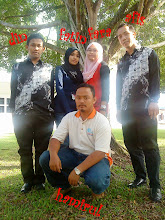Hydrostatic
Question
1. Atmospheric pressure is about 100kPa. How large a force does the air in a room exert on the inside of a window pane that is 40cm x 80cm?
The atmosphere exerts a force normal to any surface placed in it. Consequently, the force on the window pane is perpendicular to the pane and I given by
F = pA
= (100 kN/m²)(0.40 x 0.80 m²)
= 32 kN.
2. Find the ratio of a systolic blood pressure of 120 (in mmHg) to atmospheric pressure. Standard atmospheric pressure is 1.01 x 10⁵ Pa.
Pressure due to 0.120m of mercury = ρgh = (136000)(9.8)(0.120)
= 0. 16x10⁵ Pa
Ratio = 0.16 / 1.01
= 0.16
3. A hydraulic lift is to be used to lift a truck weighting 5000lb. if the diameter of the large piston of the lift is 1 ft, what gauge pressure in Ib/in² must be applied to the oil?
4. The gauge pressure in the oil acts, by Pascal’s Principle, on the bottom of the large piston to produce the force that lifts the load:
∆p = F/A
= 5000 / πr²
= 5000 / π(0.5²)
= 6370 Ib /ft²
= 6370 / 144
= 44.2 Ib/in²
4.Find the pressure exrted on the skin of a balloon if younpreess with a force 2.1N using (a) your finger or(b) a needle. Assume the area of yuor fingerip is 1.0 ×10⁻⁴m²,and the area of the needle tip is 2.5×10⁻⁷m².(c) Find the minimum force necessary to pop the balloon with the needle, given thatbthe balloon pops with a pressure of 3.0×10⁵N/m².
Solution
(a) P=F/A=2.1N/1.0×10⁻⁴m² = 2.1×10⁴N/m²
(b) P=F/A=2.1N/2.5×10⁻⁷m² = 8.4×10⁶N/m²
(c) F=PA
F=(3.0×10⁵N/m²)(2.5×10⁻⁷m²)=0.075N
5.A cubical box 20.00 cm on a side is completely immersed in a fluid. At the top of the box the pressure is 105.0 kPa;at the bottom the pressure is 106.8 kPa. What is the fluid?
Solution
ρ = P₂-P₁/gh
ρ =1.068×10⁵Pa-1.050×10⁵Pa/(9.81m/s²)(0.2000 m)
=920 kg/m³
6.A steel beam used in the construction of a bridge is 10.2 m long with a cross- sectional area of 0.12m². it is mounted between two concrete aboutments with no room for expansion. When the temprature rises 10⁰c, such a beam will expand in lenght by 1.2mm if it is free to do this expansion from happening?. Young ‘s modulus for steel is 2.0×10¹¹ N/m².
Solution
F = Y(∆L/Lo)A
Young modulus = 2.0×10¹¹ N/m²
∆L = 1.2mm – convert to (m²) = 1.2×10⁻³m
Lo = 10.2 m
A = 0.12 m²
F = (2.0×10¹¹ N/m²)(1.2×10⁻³m/10.2 m)(0.12m²)
=2.824×10⁶ N
7.A cube of jell-o 6cm on a side sits on your plate. You exert a hurizontal furce of 0.20N on top surface parallel to the surface and observe a side ways duspalacement of 5mm.what is the shear modulus of the jell-o?
Solution
Shear modulus, S=(F/A)/(∆x/h)
S = F/h∆n =0.20N/(6×10⁻²m)(5×10⁻³)
=0.20N/3×10⁻⁴
=0.667kNm⁻²
8.A 500N object is hung from the end of awire of cross-sectional area 0.010×10⁻⁴m² as in agure(a).the wire stretches from its origanal lenght of 200.00×10⁻²m to 250.00×10⁻²m.
(i) What is the stress on the wire?
Solution
Stress= F/A
=500N/0.010×10⁻⁴m³
=500×10⁶Nm⁻²
(ii) What is the strain on the wire?
Solution
Strain = ∆L/Lo
=200.00×10⁻²m - 250.00×10⁻²m.
=0.5×10⁻²m
=0.5×10⁻²m/200×10⁻²
=2.5×10⁻³m
(iii) Determine the Young’s modulusof the wire?
Solution
Young’s modulus, Y=(F/A)/ (∆L/Lo)
=500×10⁶Nm⁻²/2.5×10⁻³m
= 2×10¹¹N
9.When an object is submerged in the ocean to adepth of 3000m, the pressure increases by about 3030N/m² decrease in volume when ivnered to this depth? The bulk modulus of aluminum is 7×10¹⁰N/m²
solution
∆V = PV/B
∆V = (3030N/m² × 0.30m³) / 7×10¹⁰ N/m³
=909m³/7×10¹⁰
= 12.99× 10⁻⁹ m³
10.Find the exerted on the palm of your hand by atmospheric pressure.assume yuor palm measures 0.080 m by 0.10m.
Solution
F = PatA
= (1.01×10⁵Pa)(0.080m)(0.10m)
= 810 N
Subscribe to:
Post Comments (Atom)

No comments:
Post a Comment